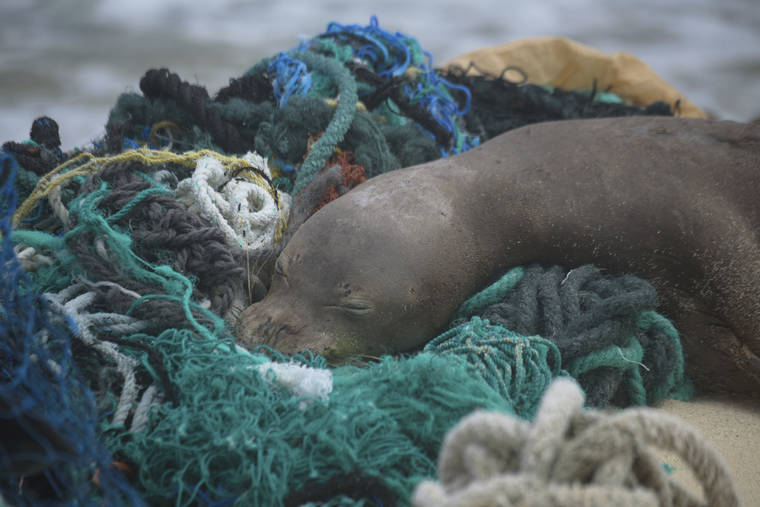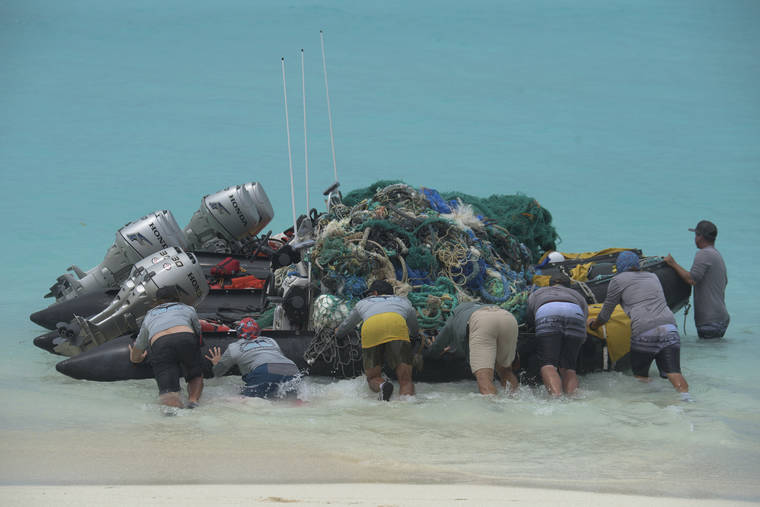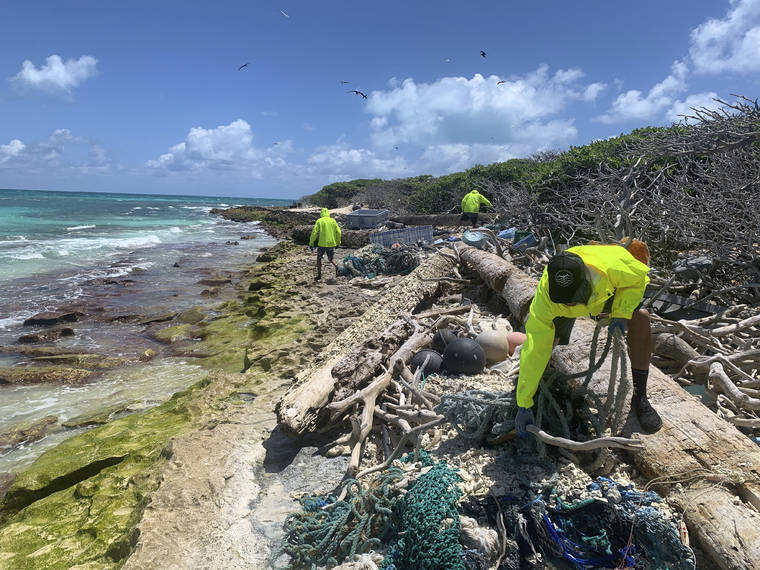Expedition hauls 47.2 tons of ghost nets, plastics out of remote Hawaii atolls


MATTHEW CHAUVIN, PAPAHĀNAUMOKUĀKEA MARINE DEBRIS PROJECT VIA ASSOCIATED PRESS
A juvenile Hawaiian monk seal rested on top of a pile of ghost nets, April 5, on the windward shores of Laysan Island in the Northwestern Hawaiian Islands. A crew returned from the remote Northwestern Hawaiian Islands with a boatload of marine plastic and abandoned fishing nets that threaten to entangle endangered Hawaiian monk seals and other marine animals on the tiny, uninhabited beaches stretching for more than 1,300 miles north of Honolulu.

MATTHEW CHAUVIN, PAPAHANAUMOKUAKEA MARINE DEBRIS PROJECT VIA ASSOCIATED PRESS
Workers with the Papahanaumokuakea Marine Debris Project pushed small boats loaded with fishing nets and plastic, April 10, off Kure Atoll in the Northwestern Hawaiian Islands. A crew returned from the remote Northwestern Hawaiian Islands with a boatload of marine plastic and abandoned fishing nets that threaten to entangle endangered Hawaiian monk seals and other marine animals on the tiny, uninhabited beaches stretching for more than 1,300 miles north of Honolulu.

KEVIN O’BRIEN, PAPAHĀNAUMOKUĀKEA MARINE DEBRIS PROJECT VIA ASSOCIATED PRESS
Workers with the Papahanaumokuakea Marine Debris Project removed fishing nets and plastic from the shoreline of Lisianski Island, April 13, in the Northwestern Hawaiian Islands.




A team of scientists has hauled another 47.2 tons of marine debris from Papahanaumokuakea Marine National Monument Opens in a new tabfollowing a 24-day expedition, just in time for Earth Day.
The National Oceanic and Atmospheric Administration says the team headed out aboard the M/V Imua, a 180-foot charter supply vessel, and returned to Honolulu with their haul late Tuesday.
The team of 12 led by the local Honolulu nonprofit Papahanaumokuakea Marine Debris Opens in a new tabProject Opens in a new tab, included staff from NOAA Fisheries, the state Division of Forestry and Wildlife, U.S. Fish and Wildlife Service, and Hawaii Pacific University’s Center for Marine Debris Research.
On the first day, the team happened to be in the right place at the right time — and was able to disentangle a female Hawaiian monk seal from fishing net wrapped tightly around her neck.
“That success gave us the motivation to work as hard as we possibly could to remove every bit of debris that we could on this expedition,” said Kevin O’Brien, project lead of the Papahanaumokuakea Marine Debris Project, in a news release. “This is the one critical issue facing the wildlife of Papahanaumokuakea that we can really do something about. There is so much to love about this incredible place. If we’re not up there cleaning up this threat, nobody is. We’d be overlooking our kuleana (responsibility) to this place if we didn’t do everything we can to make these projects happen.”
The haul of 47.2 tons, or about 94,400 pounds, included derelict fishing gear and ocean plastics.
Don't miss out on what's happening!
Stay in touch with breaking news, as it happens, conveniently in your email inbox. It's FREE!
The fishing gear, also known as ghost nets, was about 80,000 pounds of the total haul. The remaining 14,000 pounds came from ocean plastics, which included everything from fishing buoys and baskets to plastic bottles and caps, jugs, tires, cigarette lighters, foam, plastic fragments and more.
In addition to cleaning about 10 linear miles of shoreline habitat at the remote islands and atolls, the team disentangled the Hawaiian monk seal, along with three black-footed albatross chicks and an iwa, or great frigatebird, from marine debris.
Papahanaumokuakea, the largest, contiguous, fully protected conservation area under the U.S. flag, encompasses 582,578 square miles, and is home to some of the most vulnerable Hawaiian wildlife species, with its habitat used by seabirds, turtles and seals.
During the expedition, the team made it to Kamole (Laysan Island), Kapou (Lisianski Island), Kuaihelani (Midway Atoll), Lalo (French Frigate Shoals), and Holaniku (Kure Atoll), which is at the end of the chain and more than 1,300 miles from Honolulu.
At Kure, where field camp crew remove derelict fishing gear year-round, they picked up 27,000 pounds collected over three years.
“Marine debris poses a threat to wildlife throughout the monument,” said USFWS Monument Superintendent Jared Underwood in the release. “Working with partners is essential when it comes to addressing such a widespread problem -—efforts like this clean-up demonstrate the importance of collaborative conservation management.”
The team followed strict COVID-19 protocols, including testing and a mandatory, 14-day quarantine, as well as Hawaiian cultural protocols, for this expedition.
Most of the debris will be incinerated and converted into energy, while some plastics will be set aside for a student-led ocean recycling project. Another five tons of ghost nets will be used for research at HPU, which is attempting to identify their origins.
Since 1996, teams have been heading to the monument to remove marine debris. To date, they have removed more than 2 million pounds.



